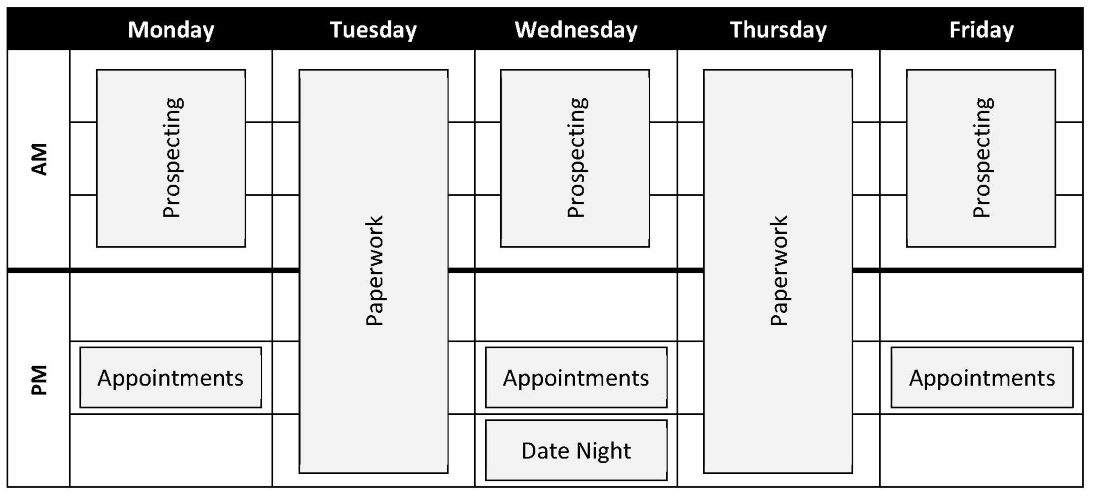One of the questions I get asked all the time is, “How do I bring in more business?” Right behind that is, “How do I get it all done?” Those are related, of course: If you’re bringing in more business, you’ll have more work that has to get done. And unless you want a reputation problem on your hands, you have to find a way to get that additional work done with the same exceptional level of quality.

It’s not just client work that we struggle to find time for. We need time for the administrative work of our business. We need time to manage and mentor our employees. We need time to develop ourselves and to invest in our business and—yes, even and especially—to enjoy life and our friends, family and community.
We’ve all heard the saying there’s only twenty-four hours in a day, and no matter how much you wish otherwise, the earth will keep spinning at the same speed and moving around the sun in the same amount of time.
Don’t be discouraged, though: The secret of time is that there actually is enough of it. What matters isn’t the number of hours in a day but how we use those hours.
Getting Ready for Vacation—Every Day
I’m sure you’ve had those days when you got more done than you thought possible. In my experience, this miraculous ability most often comes over us when we’re getting ready to go on vacation. Because we don’t want to take work with us, we’re at our most productive; we find a sense of urgency and don’t allow ourselves to be distracted. It’s that kind of focus that we should go for in our every day work—though without the stress that often comes with it.
How do we get that? How do we find time when we can’t create more of it and we can’t control how fast it goes? We find time by saving time. And we can do that in six simple steps.
Step 1: Clear Your Mind
A mind that is too full is a noisy, distracted mind. The same way it’s hard to get work done in a chaotic space, it’s hard to focus if your mind has too much going on. To start your day off right, start your day off by clearing your mind.

There are a lot of ways to do this. I sit down each morning with a cup of coffee and a daily devotional. I have friends who pray or meditate and friends who go for a run or walk. Some people find quiet by walking their dog. Others clean out their heads by writing down everything they’re thinking about or worrying about or everything they need to get done in the day. Some write in a diary or a journal or just sit quietly with a cup of tea or coffee in a pleasant space.
You may need to experiment to find what works for you, but if you start each day by clearing your mind, you’re going to find that you have more energy, more ability to concentrate and more capacity for thinking creatively and solving problems.
It can be hard at first to find time for something that doesn’t necessarily feel directly productive, but when it becomes part of your routine you’ll probably find it’s the most important part of your day. For more on developing routines, including taking time for yourself to clear your mind, check out my blog Routine: Your Secret Weapon.
Step 2: Organize Your Space

Quick quiz: If I called you right now and told you I would give you a hundred bucks if you could find the third-to-last contract or client agreement you wrote, how long would it take you? Thirty seconds? Ten minutes? An hour? A lot of us spend a lot of time digging through paperwork or computer files, looking for the right pen or the right label, searching through emails for the one we need. Every second we spend hunting is a second we’re not actually being productive.
We all have different ways of clearing our heads, and we all have different ways of organizing our space. What’s important is that however you do it—color-coded file folders or containers, designated work zones, to-do lists on your phone or sticky notes on your wall—be sure that it works. You’ll know a system is working when you can find what you need when you need it, when you know what’s next on your priority list, when you’re making it to meetings on time, and when you’re meeting deadlines and you have a sense of control and peace when you’re in your workspace.
If you’re working from home for the first time, check out my blog Succeed—and Stay Sane—While Working From Home for some great tips.
Step 3: Minimize Distractions

Distractions are one of the great killers of time, and our lives are full of them. Clearing your mind reduces your internal and mental distractions. Organizing your office cuts back on physical distractions. But there are still all those social distractions: constant emails and texts; the burning desire to find out what you’re missing on social media; the employees—or now that so many of us are working from home, the spouses and kids and pets—who keep popping in. Some of it’s legitimate work that needs to get done, some of it isn’t, but when you’re pulled in a million different directions to do a million different tasks, you’re not going to do any of them well.
The fact is, humans aren’t very good at multitasking. We’re much more efficient and effective when we focus on one task or topic at a time. Of course, we have to answer those texts and emails, and we do need to check in with the outer world, including our families and employees. We just have to do those things in a way that doesn’t sap the day away.
Try turning off the text alarms on your phone and checking texts and emails three times a day instead of every 10 minutes. Give yourself a fixed amount of time—during a break, with a timer set—to find out what’s going on over on Facebook (if you really have to know). If social media is an important part of your business, put time to do it on your calendar. (We’ll talk more block calendars below.) Limit your open door policy to scheduled hours a day, like a college professor (tweed jacket and elbow patches optional).
Feel like that’s a lot of trouble? Consider this: Whenever you allow yourself to be sidetracked, it takes your brain 15 to 25 minutes to get back on task. Since most of us will be interrupted again in that 15 to 25 minutes, we spend a lot of our day—maybe most of our day—working well below our most productive.
Step 4: Block Your Time
Let’s go back to that statement about humans not being very good at multitasking. Multitasking has been a buzzword for a long time, and we all like to think we’re awesome at multitasking, that the ability to focus on multiple things at once makes us smarter or more effective or more powerful. The truth is, whenever we think we’re multitasking, what we’re actually doing is making our brain flip back and forth between tasks. Not only does this wear us out, it’s an inefficient use of our brain, and it leads to mistakes. When we focus on solving one problem or accomplishing one task at a time, we work more creatively and with more accuracy. We also work faster, so we have more time in our day to get more things done and done well.
The most effective way of doing this that I’ve found is called block scheduling. You categorize the tasks you need to accomplish each day, then set aside blocks of time to get them done. You might dedicate two hours in the morning for following up on prospects, two hours midday for paperwork and three hours in the afternoon for client appointments. Your blocks might vary throughout the week: Maybe you like to work on prospects on Monday, Wednesday and Friday and catch up on paperwork on Tuesday and Thursday.

A block calendar keeps you focused on the tasks you need to complete to bring in business and get your work done, but it can also help you manage your level of busyness and tension. By making sure that you include buffer time for those inevitable emergencies, as well as personal time for yourself and your family, you’re building a calmer, more complete and more satisfying world to operate in. Plus, you get everything that you need to get done, done!
I can’t stress the importance of including personal time in your block calendar. I promise that it will make an amazing difference in your life. But you don’t have to take my word for it: You can read about how block timing was one of the things that caused a client of mine to tell me she had a life for the first time in 18 years. Read her story at Living Is More Than Just Working.
Step 5: Don’t Do Everything Yourself
We all know that as small business owners and professionals, we wear many hats. Large corporations can afford to hire separate experts to tackle, for instance, marketing and operations, but you have to be an expert on pretty much everything your business does. If you look at jobs that describe what you do, you’ll probably find that you do sales, marketing, accounting, management and operations—maybe even some janitorial work. I once counted the types of tasks I do and came up with the equivalent of 10 jobs!

That’s the reality of working in small business. But here’s another reality: If you’re doing 50% or more of the functions of your business, you’re working too hard in your business and you don’t have the time to work on your business.
This is an important distinction. Working in your business means you’re involved in all those tasks that keep the doors open: You’re making sales, writing contracts, following up on payments, managing delivery, making calls. Every minute you spend on those day-to-day jobs is a minute you’re not working on your business: growing, expanding and turning your vision into reality. In fact, we’ve found that for every one hour you work on your business, you save three hours in your business.
So if you’re doing more than 50% of the work of your business, it’s time to make some changes: implement a software or system to automate a task; farm out an administrative task like accounting; develop processes and procedures so your employees can take on more responsibility; delegate work that you either don’t enjoy or that doesn’t generate income. And hire an assistant. That’s so important that I actually dedicate the next entire step to it.
Let me say this before we move on, though: I know this can be hard. The thing about being a small business owner or professional is that we’re used to doing this on our own. Many of us got into the business we’re in because we wanted to be our own boss; we wanted to have things done a certain way. That’s totally fine—if you want to stay exactly where you are. But if you want to have the business you’ve always dreamed of, you’re going to have to find people to travel with you on this journey. People you trust, yes. People who deliver, absolutely. But you have to find them. Have a look at my blog Letting Go to Grow for more on how to make the transition.
Step 6: Hire an Assistant

I’ve been talking a lot about assistants lately, but at risk of sounding like a broken record, I need to say it again: Please, please hire an assistant! I know it might feel like an extravagance and yes, it costs money, but by hiring an assistant you will free yourself up to do the important work of your business, the work that really brings in money.
I’m not talking a $40,000-a-year full-time assistant. For $250-300 a week, you can bring someone on to manage your calendar and paperwork, do some client care, maybe even take on your CRM system. How many additional clients would you have to bring on to pay for that? How many additional clients would you bring in if you had some extra time?
I can tell you that when I got an assistant, I went from $3,000 to $4,000, just like that. When I got an assistant and a half, I went up to $6,000.
When you have someone helping you out with the administrative tasks of your business, you have more time to take your business to the next level. That means impacting more lives: the lives of your customers, of your employees, of yourself and your family. There’s also a mental and emotional benefit. I think it has to do with having other people to play with, team with, partner with. Other people to share your vision and passion with; other people who are working toward the same goals.
So hire an assistant. Pretty pretty please.
Make Time Your Own
Back to time. We talk a lot about time in our culture. We talk about time marching on and waiting for no one, about killing time, about time being money or slipping away like sand. Philosophers and writers have weighed in on time for thousands of years: Ben Franklin, Shakespeare, Pericles, Steve Jobs, Einstein, Dr. Seuss.
You can’t control time. You can’t stop time. But you don’t need to. You have the tools you need—right now—to find more time by saving time. You save time by cutting out the distractions in your mind and your space; by organizing your calendar and your business; by choosing the right people to travel this journey with you.
Need a little more inspiration? Let me leave you with a few more sayings: Time is of the essence. Don’t wait another day. There’s no time like the present. The time is now.
For a deeper dive on the topic, reach out to one of our Certified Business Coaches™ for complimentary coaching session Click Here




































































